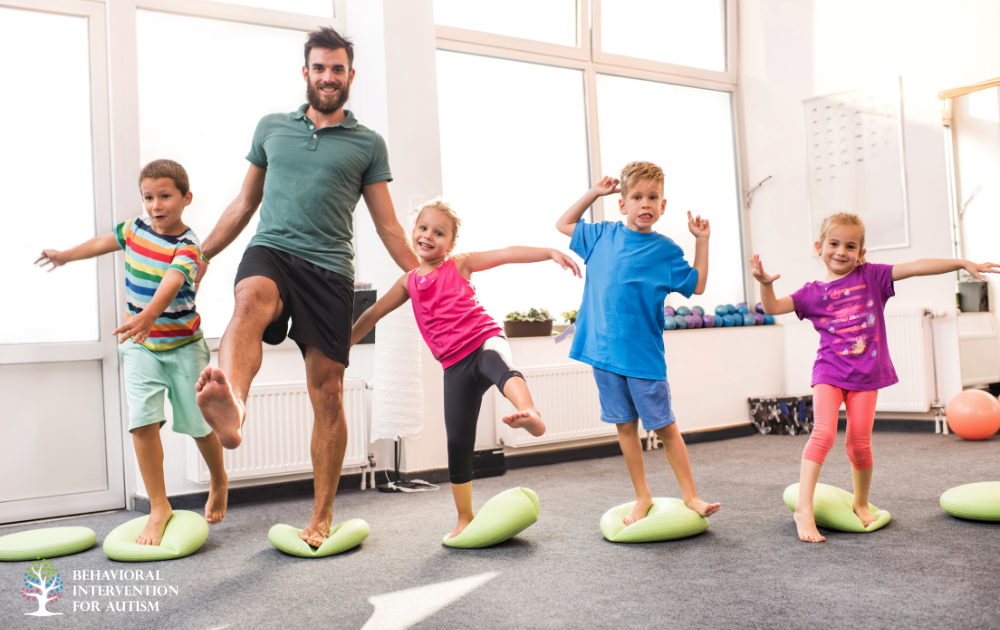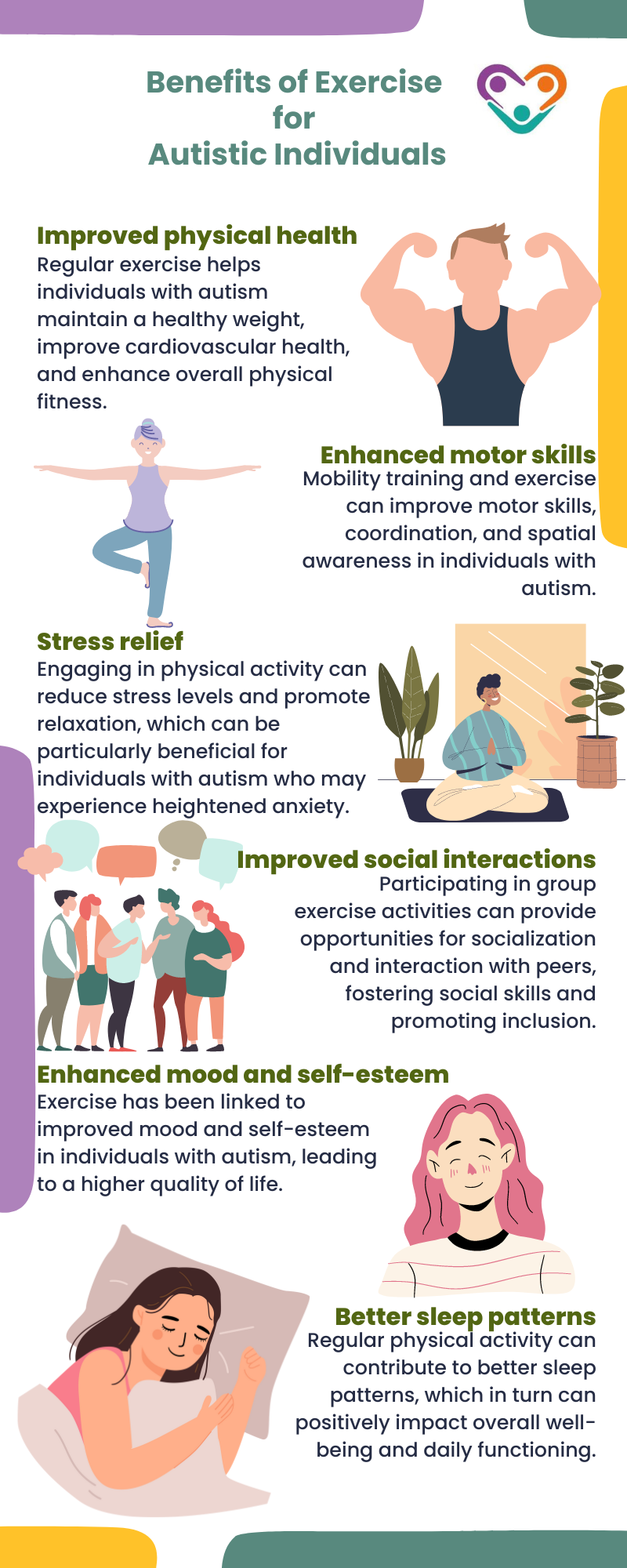
Table of Contents
For individuals with autism, mobility training is essential for enhancing their motor skills, coordination, and overall physical abilities. Engaging in regular exercise and mobility training can have a positive impact on various aspects of their lives. Routine exercise has been proven to relieve stress, decrease the likelihood of emotional meltdowns, and improve endurance and flexibility.
By participating in mobility training, individuals with autism can become more self-assured, calmer, and less likely to engage in erratic behaviors.
In addition to the immediate benefits, mobility training also promotes long-term physical health. Functional strength training, which includes exercises like squats, push-ups, and planks, can help individuals with autism improve muscle tone, strength, and stability. These exercises enable them to perform daily activities more effectively and prevent issues such as muscle overuse, injury, and discomfort later in life.
Recommended Mobility Training Exercises
As far as mobility training for individuals with autism goes, there are several recommended exercises that can help improve strength, coordination, and overall physical fitness. These exercises are not only beneficial for individuals with autism but can also be performed without disturbing any assistive devices they may be using.
Let’s have a look at what these are.
Medicine Ball Slam Exercise
The medicine ball slam exercise is a highly recommended exercise for individuals with autism. This exercise involves lifting a medicine ball overhead and forcefully slamming it onto the ground.
It helps relieve tension, build strength, and work the core muscles. The best part is that it can be performed while standing.
Kettlebell Deadlift Exercise
Another effective exercise for individuals with autism is the kettlebell deadlift. This exercise involves lifting a kettlebell from the ground to a standing position, focusing on the lower body and core muscles.
Like the medicine ball slam exercise, the kettlebell deadlift can be performed while standing.
Plank Exercises
Plank exercises are highly recommended for core strengthening. They help improve stability and strengthen the abdominal muscles. For individuals with autism who may have discomfort lying on their back, plank exercises are a great alternative.
Planks can be performed in a variety of positions, such as a forearm plank or a high plank, allowing individuals to exercise their core without having to lie on their back.
Incorporating these recommended exercises into a mobility training routine can help individuals with autism improve their strength, coordination, and overall physical well-being. Remember to always consult with a healthcare professional or occupational therapist before starting any exercise program to ensure that it is safe and suitable for the individual’s specific needs.
Core Strengthening Exercises
Core strengthening exercises play a vital role in mobility training for individuals with autism. These exercises focus on strengthening the muscles in the abdomen, back, and pelvis, which provide stability and support for the entire body.
Here are three core strengthening exercises that can be beneficial for autistic individuals:
Push-Up Exercises
Push-up exercises are considered beneficial for children with autism as they can be done from the plank position. Push-ups primarily target the muscles in the chest, shoulders, and arms, but they also engage the core muscles for stability.
To perform a push-up, start in a plank position with hands shoulder-width apart and legs extended behind you. Lower your body by bending your elbows, keeping your back straight, until your chest is near the ground.
Push back up to the starting position. Modifying push-ups by performing them against a wall or on an incline can make them more accessible for individuals with varying levels of strength.
Motor Planning Exercises
Motor planning exercises are crucial for individuals with autism as they help improve coordination, timing, locomotion, lateral movement, hip flexion, and stability. These exercises focus on activities that require multi-step movement patterns and can help individuals be more fluid in their movements.
Some examples of motor planning exercises include:
- Obstacle courses – Set up a course with objects to navigate around, step over, and crawl under, encouraging the individual to plan and execute movements.
- Simon says – Play the game “Simon says” to practice following multi-step instructions and performing different actions.
- Dance routines – Learn and practice dance routines that involve coordinated movements and footwork.
By incorporating motor planning exercises into mobility training, individuals with autism can enhance their coordination skills and overall motor control.
Functional Strength Training
Functional strength training focuses on exercises that mimic real-life movements and help individuals with autism improve muscle tone, strength, and stability. These exercises enable them to perform daily activities more effectively and can also help prevent issues like muscle overuse, injury, and discomfort later in life.
Some examples of functional strength training exercises include:
- Squats – Squats target the muscles in the legs and buttocks, promoting lower body strength and stability.
- Lunges – Lunges work the muscles in the legs and hips, improving balance and coordination.
- Planks – Planks engage the core muscles, promoting overall stability and strength.
When performing functional strength training exercises, it’s important to start with appropriate modifications and progress gradually based on individual abilities and comfort levels. Consulting with a healthcare professional or a qualified trainer can help ensure safe and effective implementation of these exercises.
Incorporating core strengthening exercises like push-ups, motor planning exercises, and functional strength training into mobility training for individuals with autism can contribute to improved muscle tone, coordination, stability, and overall mobility.
Adaptive Fitness Exercises
Adaptive fitness exercises also play a crucial role in promoting body movements, coordination, and socialization skills among autistic individuals. Here are three effective adaptive fitness exercises worth considering:
Scramble Exercise
The Scramble exercise is a highly recommended adaptive fitness exercise for individuals with autism. It focuses on enhancing body movements, balance, listening skills, and coordination.
This exercise involves lying on the stomach, transitioning to a quadruped position, and quickly bending the knees and jumping up.
The Scramble exercise provides a fun and engaging way to improve motor skills and body awareness. It challenges individuals to coordinate their movements and develop better control over their bodies. By incorporating this exercise into a regular routine, individuals with autism can experience improvements in their physical abilities and overall coordination.
Bear Crawls
Bear Crawls are another beneficial exercise for individuals with autism. This exercise promotes proper body awareness, stabilizes the shoulders, strengthens the trunk, and improves motor planning. To perform bear crawls, one starts in a quadruped position and walks using both hands and feet, without turning the hands into fists.
By engaging in bear crawls, individuals with autism can develop better proprioception or the sense of their body in space. This exercise helps them gain a deeper understanding of their body’s movements and positions.
Additionally, bear crawls can strengthen the core muscles and improve overall stability, leading to better control and coordination.
Mirror Exercises
Mirror exercises are effective in encouraging individuals with autism to mimic movements, improving coordination between the brain and body, increasing body awareness, and enhancing socialization skills. This exercise involves partnering with someone and copying their movements.
Starting with simple movements and progressing to more complex ones, individuals with autism can develop their motor skills and coordination abilities.
Mirror exercises provide an opportunity for individuals with autism to engage in social interactions while focusing on their own physical movements. The mirroring aspect creates a sense of connection and cooperation, promoting socialization and communication skills. This exercise can be tailored to the individual’s abilities and interests, ensuring a personalized and enjoyable experience.
Benefits of Exercise for Autism
Exercise offers numerous benefits for individuals with autism, both physically and emotionally. Some of the key advantages include the following:
By incorporating these exercises into mobility training, individuals with autism can reap the benefits of improved physical abilities, coordination, and socialization skills. It is important to consult with a healthcare professional or occupational therapist to determine the most suitable exercises for each individual’s needs and abilities.
At Behavioral Intervention For Autism, our dedicated team offers a comprehensive ABA therapy in Florida. We provide tailored interventions to address specific challenges and improve overall well-being.
Interested in how our services can make a difference for you? Reach out to us today to explore how we can help.
Sources:
https://www.specialstrong.com/adaptive-fitness-exercises-for-autism
https://www.angelsense.com/blog/fitness-exercises-for-children-with-autism
https://www.livestrong.com/article/13770742-exercise-and-autism
- 9 Common Obsessions of Children With Autism You Should Know - February 25, 2025
- What is Neurodiversity? A Guide to Embracing Differences - February 25, 2025
- Understanding Hyperfocus in Autism: What It Means and Why It Happens - February 25, 2025




